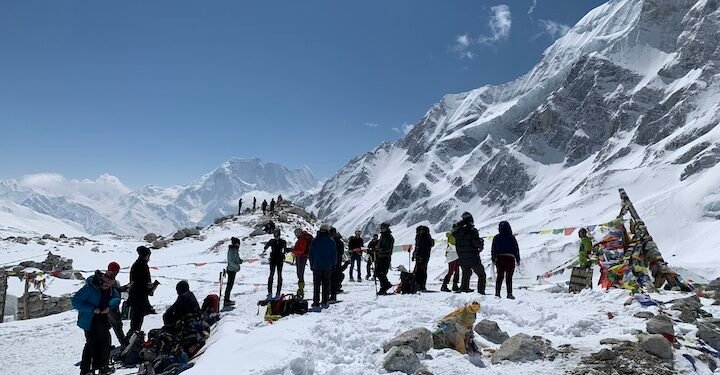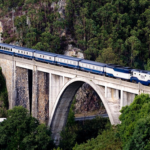The Langtang Valley trek is a mesmerizing journey through one of Nepal’s most scenic and culturally rich regions. Nestled in the Langtang National Park, it offers a blend of natural beauty, diverse landscapes, and the warm hospitality of the local Tamang people.
Starting from Syabrubesi, the trek gradually ascends through lush rhododendron forests and picturesque villages. The trail follows the Langtang River, providing stunning views of terraced fields, waterfalls, and snow-capped peaks. As you ascend higher, the scenery transitions to alpine meadows and eventually opens up to reveal the magnificent Langtang Lirung (7,227m), the highest peak in the area.
The cultural aspect of the Langtang Valley trek is equally captivating. Villages like Lama Hotel, Mundu, and Kyanjin Gompa offer insight into the traditional Tamang way of life. Visitors often stay in teahouses run by local families, providing an authentic experience of Nepalese hospitality and cuisine.
Kyanjin Gompa, nestled at 3798 meters, is the trek’s centerpiece. Trekkers can explore ancient monasteries, visit a cheese factory, or hike up Kyanjin Ri for breathtaking panoramic views of the surrounding peaks, including Langtang Lirung, Dorje Lakpa, and Langshisha Ri.
For those seeking further adventure, side trips can be arranged to Tserko Ri or Langshisha Kharka, which offer challenging hikes with rewarding views.
The Langtang Valley trek is not just about natural beauty and cultural immersion; it also holds a special place in the hearts of trekkers due to its rebuilding efforts after the devastating earthquake of 2015. The local communities’ resilience and commitment to rebuilding trekking infrastructure have made Langtang Valley a symbol of hope and renewal.
The Langtang Valley trek perfectly blends nature, culture, and resilience. Whether you’re a novice trekker or a seasoned adventurer, this trek promises unforgettable experiences amidst the awe-inspiring Himalayan landscape.
Discovering Nepal’s Serene Gem: The Langtang Valley
Immerse yourself in the awe-inspiring beauty of Nepal’s Langtang Valley Trek, where every step unveils breathtaking landscapes and rich cultural encounters. Trekking through verdant rhododendron forests, quaint Tamang villages, and alongside the turquoise waters of the Langtang River, you’ll be captivated by the natural splendor surrounding you. The trail gradually reveals panoramic views of towering snow-capped peaks, including the majestic Langtang Lirung. At the heart of the journey lies Kyanjin Gompa, a picturesque village adorned with ancient monasteries and a lively yak pasture. Here, you can engage with local Tamang communities, sample traditional cuisine, and witness firsthand the warmth and hospitality of the Nepalese people.
For the adventurous spirit, optional hikes to Tserko Ri or Langshisha Kharka offer exhilarating challenges and unparalleled vistas of the Himalayas. The Langtang Valley Trek is not just an expedition into nature’s wonders but also a cultural odyssey, where the resilience and spirit of the region’s inhabitants shine through, making it a journey that leaves a lasting impression on every traveler.
Ideal Seasons for Exploring: Best Times to Visit Langtang Valley
The best time to visit the Langtang Valley trek is during the spring (March to May) and autumn (September to November) seasons. The valley bursts into vibrant colors during spring as rhododendron forests bloom with various hues, creating a picturesque backdrop against the snow-capped peaks. The weather is generally mild and pleasant, making it ideal for trekking without the extreme cold of winter or the monsoon rains that arrive later in the year.
Autumn is equally favorable, with clear skies and stable weather conditions. The visibility improves significantly during this time, offering spectacular views of the surrounding Himalayan peaks, including Langtang Lirung and Ganesh Himal. The temperatures are moderate during the day, although it can get chilly at higher altitudes, especially in the evenings.
Summer (June to August) is the monsoon season in Nepal. It brings heavy rainfall and often obstructed views due to clouds and mist. Trekking during this time can be challenging due to slippery trails and leeches in lower elevations, although the landscapes appear lush and green.
Winter (December to February) sees cold temperatures and occasional snowfall, particularly at higher altitudes. While the views can be stunning after fresh snowfall, trekking conditions are more challenging, and some lodges may be closed due to the harsh weather.
In summary, the spring and autumn months offer the best conditions for trekking in the Langtang Valley. They provide pleasant weather, clear skies, and breathtaking vistas of the Himalayas and the region’s natural beauty.
Essential Tips for a Successful Langtang Valley Trek
Check out these helpful tips provided by Nepal Hiking Team, a premier trekking agency in Nepal.
- Seasonal Timing: Plan your Langtang Valley trek during the optimal spring seasons (March to May) and autumn (September to November) to enjoy the best weather and clear views of the Himalayan peaks. Spring offers blooming rhododendron forests, while autumn provides stable weather and visibility.
- Acclimatization: Take time to acclimatize properly to the altitude. Gradual ascent and rest days at strategic points like Lama Hotel and Kyanjin Gompa help mitigate the risk of altitude sickness, ensuring a safer and more enjoyable trekking experience.
- Pack Wisely: Pack light but efficiently. Essential items include sturdy trekking boots, warm clothing layers (including a down jacket), a good quality sleeping bag, sunscreen, sunglasses, and a hat. Ensure your backpack is comfortable and distribute weight evenly.
- Hydration and Nutrition: Drink plenty of water throughout the day. Carry water purification tablets or a filter to refill from streams (after treatment). Consume high-energy foods like nuts, chocolate, and local meals rich in carbohydrates and proteins to sustain energy levels.
- Respect Local Culture: Embrace the local customs and traditions of the Tamang people. Always ask before photographing individuals or religious sites. Participate respectfully in local customs and ceremonies encountered along the trail.
- Stay Informed: Keep updated on weather forecasts and trail conditions. Check-in with local guides, fellow trekkers, or lodge owners for the latest information on routes and any potential challenges ahead.
- Environmental Awareness: Practice responsible trekking by carrying out all non-biodegradable waste. Avoid single-use plastics where possible. Respect wildlife and natural habitats encountered along the trail.
- Travel Insurance: Obtain comprehensive travel insurance that covers trekking activities, including emergency medical evacuation. Confirm your policy covers high-altitude trekking in Nepal.
Following these tips enhances safety, enjoyment, and cultural sensitivity throughout your Langtang Valley trekking experience.
Reflections on the Langtang Valley Trek: Nature, Culture, and Resilience
In conclusion, the Langtang Valley trek is a testament to Nepal’s breathtaking natural beauty and cultural richness. Whether traversing through blooming rhododendron forests in spring or enjoying clear vistas of snow-capped peaks in autumn, this trek offers an unforgettable journey for adventurers and nature enthusiasts. The hospitality of the Tamang communities, the serene landscapes, and the challenging yet rewarding trails combine to create an experience that leaves a lasting impression.
Beyond its scenic allure, the trek also highlights the resilience of the local people, who have rebuilt their lives and hospitality infrastructure following the 2015 earthquake. Visitors can witness firsthand the spirit and warmth of these communities, making meaningful connections beyond the physical landscapes.
As you traverse the trails of Langtang Valley, each step reveals a new facet of Nepal’s Himalayan charm, from the tranquility of Kyanjin Gompa to the panoramic vistas atop Tserko Ri. Whether a seasoned trekker or a first-time adventurer, this trek promises moments of awe, introspection, and connection with nature and culture, making it a journey cherished long after the trekking boots are put away.

















